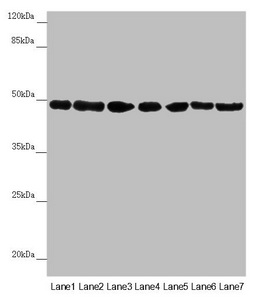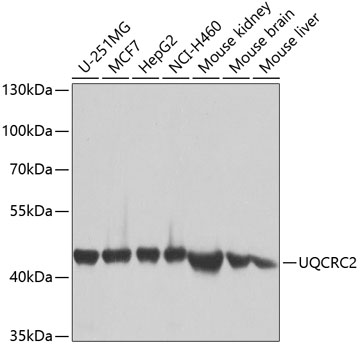UQCRC2 antibody
GTX114873
ApplicationsImmunoFluorescence, ImmunoPrecipitation, Western Blot, ImmunoCytoChemistry, ImmunoHistoChemistry, ImmunoHistoChemistry Paraffin, Other Application
Product group Antibodies
TargetUQCRC2
Overview
- SupplierGeneTex
- Product NameUQCRC2 antibody
- Delivery Days Customer9
- Application Supplier NoteWB: 1:5000-1:20000. ICC/IF: 1:100-1:1000. IHC-P: 1:100-1:1000. IP: 1:100-1:500. *Optimal dilutions/concentrations should be determined by the researcher.Not tested in other applications.
- ApplicationsImmunoFluorescence, ImmunoPrecipitation, Western Blot, ImmunoCytoChemistry, ImmunoHistoChemistry, ImmunoHistoChemistry Paraffin, Other Application
- CertificationResearch Use Only
- ClonalityPolyclonal
- Concentration1.37 mg/ml
- ConjugateUnconjugated
- Gene ID7385
- Target nameUQCRC2
- Target descriptionubiquinol-cytochrome c reductase core protein 2
- Target synonymsMC3DN5, QCR2, UQCR2, cytochrome b-c1 complex subunit 2, mitochondrial, complex III subunit 2, cytochrome bc-1 complex core protein II, ubiquinol-cytochrome c reductase core protein II, ubiquinol-cytochrome-c reductase complex core protein 2
- HostRabbit
- IsotypeIgG
- Protein IDP22695
- Protein NameCytochrome b-c1 complex subunit 2, mitochondrial
- Scientific DescriptionThis is a component of the ubiquinol-cytochrome c reductase complex (complex III or cytochrome b-c1 complex), which is part of the mitochondrial respiratory chain. The core protein 2 is required for the assembly of the complex.
- Storage Instruction-20°C or -80°C,2°C to 8°C
- UNSPSC12352203
References
- Lee H, Lee TJ, Galloway CA, et al. The mitochondrial fusion protein OPA1 is dispensable in the liver and its absence induces mitohormesis to protect liver from drug-induced injury. Nat Commun. 2023,14(1):6721. doi: 10.1038/s41467-023-42564-0Read this paper
- Avolio R, Agliarulo I, Criscuolo D, et al. Cytosolic and mitochondrial translation elongation are coordinated through the molecular chaperone TRAP1 for the synthesis and import of mitochondrial proteins. Genome Res. 2023,33(8):1242-1257. doi: 10.1101/gr.277755.123Read this paper
- Matassa DS, Criscuolo D, Avolio R, et al. Regulation of mitochondrial complex III activity and assembly by TRAP1 in cancer cells. Cancer Cell Int. 2022,22(1):402. doi: 10.1186/s12935-022-02788-4Read this paper
- Zhao M, Wei H, Li C, et al. Gut microbiota production of trimethyl-5-aminovaleric acid reduces fatty acid oxidation and accelerates cardiac hypertrophy. Nat Commun. 2022,13(1):1757. doi: 10.1038/s41467-022-29060-7Read this paper
- Lee H, Smith SB, Sheu SS, et al. The short variant of optic atrophy 1 (OPA1) improves cell survival under oxidative stress. J Biol Chem. 2020,295(19):6543-6560. doi: 10.1074/jbc.RA119.010983Read this paper
- Imami K, Milek M, Bogdanow B, et al. Phosphorylation of the Ribosomal Protein RPL12/uL11 Affects Translation during Mitosis. Mol Cell. 2018,72(1):84-98.e9. doi: 10.1016/j.molcel.2018.08.019Read this paper
- Takahashi K, Ohsawa I, Shirasawa T, et al. Optic atrophy 1 mediates coenzyme Q-responsive regulation of respiratory complex IV activity in brain mitochondria. Exp Gerontol. 2017,98:217-223. doi: 10.1016/j.exger.2017.09.002Read this paper
- Lee H, Smith SB, Yoon Y. The short variant of the mitochondrial dynamin OPA1 maintains mitochondrial energetics and cristae structure. J Biol Chem. 2017,292(17):7115-7130. doi: 10.1074/jbc.M116.762567Read this paper





